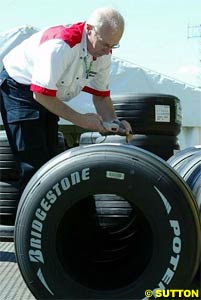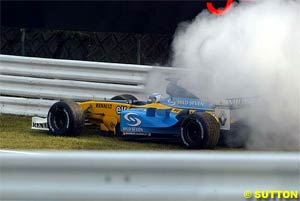
Atlas F1 Columnist
This week's Grapevine brings you |
For the first time since coming in to the sport, there is an aura of concern from Bridgestone's engineers, as they work to complete their plans for the forthcoming season. No matter how they slice it, the advantage Michelin developed through 2003 is presenting Bridgestone a significant mountain to climb.
As things stood at the conclusion of the 2003 season, BAR's data implies that a car set up correctly on Michelin tyres is only up to a quarter of a second quicker on a qualifying lap than their Bridgestone counterpart. Over a full race distance, however, the same tyres should be worth between fifteen and thirty seconds, depending on the ambient track temperature - enough for an extra pitstop. Interestingly, in the process of discovering the optimum setup, it seemed quite easy to extract up to a further second from the tyres, but only at the cost of significant wear: over a full race distance, the degradation would have cost a lot more time.
These figures tie up closely with BAR's expectations, based on their all too subjective observations of the progress their immediate rivals made over the year. And though they won't be drawn in to talking about it publicly, very similar numbers appear to have been mentioned between Ferrari and Bridgestone.
Targeting a half second a lap gain through the off season is well within Bridgestone's capabilities - they have a Ferrari with test driver at their disposal to pound off as many miles as required, whenever there is rubber available. If they need it, with a little notice, they can get up to three cars on track, wearing down test tyres. It ensures they can always get data in short order, and perpetuate the development cycle.
When they produced tyres for both McLaren and Ferrari, Bridgestone struggled to develop a solution that properly satisfied both teams. In the end, McLaren changed camp after seeing Ferrari dominating the Bridgestone development direction, whilst Michelin appeared willing to offer a genuinely even footing at the top of the billing with Williams. The immediate aftermath saw Ferrari freed to dictate Bridgestone's development completely, which apparently worked extraordinarily well with the F2002. The dominance of that car in 2002 really made it seem as though the Ferrari-Bridgestone combination was the right direction to go.
Michelin, however, were in the process of getting their act together. McLaren got on top of understanding the French rubber over the course of the season, and Renault began getting more involved with the development cycle. What started in the 2002 season as a massively conflicting set of requirements from three important teams became a far more coherent ordeal when McLaren and Williams agreed to work together, giving Michelin a consistent target for their Prime tyre, permitting them to focus the Option alternative to Renault's requirements.
As 2003 progressed, it has become apparent that having three leading teams effectively collude on the development direction of the tyres has been a significant factor in Michelin's rapid progress. Three sets of engineers all looking for advantage, each willing to permit others to benefit with the common aim of ensuring their tyres are better than Ferrari's, has been a vital factor in the campaign.
Bridgestone are confident that the current performance deficit can be closed before the season kicks off, but they do not see how to slow down Michelin's development - although it is uncertain how far the outfit will move on over the off-season, let alone as the year progresses. Until the Japanese manufacturer is able to significantly improve their rate of development, they are anticipating a constant game of catch-up.
Ferrari are confident their new car is a corker, but with tyre performance being arguably the biggest single factor in the overall pace of the package, making up for the Bridgestone deficit is going to be a season-long struggle.
Since the 2003 Heathrow agreement was discarded, the name of the game in 2004 is set to be a focus on reliability. All the teams having no trouble arriving at the same conclusion: the only way to regularly outscore opponents is going to be to beat their reliability, particularly when extraordinary circumstances, such as rain, turn the regular order upside-down. The relatively early launches that almost all the teams have scheduled are a direct reflection of the fact that a lot of testing, and bullet proof reliability, is expected to be the deciding influence come the season's conclusion.
But with the top teams all bent on getting to the reliability level enjoyed by Michael Schumacher, there is little doubt that those behind are facing the frustrating problem of finishing all their races outside the points, as the reliability of the front runners all but shuts out the other outfits. They are left with the stark choice of going for outright performance, attempting to beat a 'better' but more cautious team on merit whilst risking that the car will stay together long enough to finish in a scoring position, against shooting for reliability, which massively improves the odds of being in the right position to take advantage of what opportunity there is to score when things go wrong at the front.
The irony is that Ralf Schumacher had a significantly more reliable season than Rubens Barrichello (whose five retirements put a question mark over Ferrari's bullet-proof reputation), yet the German finished behind the Brazilian in the WC standings. Juan Pablo Montoya's reliability was on a par with Raikkonen's, yet it was two spins and a tough stop-go penalty that arguably cost him his chances. And Fernando Alonso finished the season ahead of David Coulthard, despite each having five failures to complete the course.
So, whilst reliability continues to be the much bandied-about watch-word, for the teams who expect to finish in the points more often than not, outright performance continues to be just as important a focus as ever it was. On the bright side, this resulting quest of minimising tolerances at the risk of not finishing will afford fans plenty of opportunity to experience schadenfreude at the expense of unfortunate rivals!
It is with considerable regret I announce that this, the 245th Grapevine, is to be the last under my hand, as changing circumstances will rob me of the time to do the job properly.
Some of the top stories we unravelled in this column over the last five years include:
It has been an immense pleasure bringing the column to you, and I should like to thank the many readers who have supported it over that time - thanks for making it so rewarding!
Editor's note: The Weekly Grapevine will be re-launched in its new format and with a new author in February. Tom Keeble will continue writing for Atlas F1 and will assume a new position before the 2004 season begins. The entire Atlas F1 staff thanks him for five years of rumours & speculations and an impeccable job!
![]() Bridgestone Concerned
Bridgestone Concerned
 Notwithstanding winning the 2003 Championships, the true level of Bridgestone's performance through the last season is revealed by a look at the teams they supplied besides Ferrari. BAR was so disappointed with the state of their Bridgestone tyres - particularly the lack of in-season development - that they have jumped ship before their contract ran out with Bridgestone, and joined the Michelin forces; their first test on the French rubber has been all too revealing about the current state of play.
Notwithstanding winning the 2003 Championships, the true level of Bridgestone's performance through the last season is revealed by a look at the teams they supplied besides Ferrari. BAR was so disappointed with the state of their Bridgestone tyres - particularly the lack of in-season development - that they have jumped ship before their contract ran out with Bridgestone, and joined the Michelin forces; their first test on the French rubber has been all too revealing about the current state of play.
![]() All About Reliability
All About Reliability
 Williams are ruing the points they lost from the few, telling failures they suffered in 2003. They are certain that the car was faster than McLaren's at a majority of the races - a view confirmed by the team's placing ahead of their Woking rival in the Constructors' Championship. But they were frustrated that it was Kimi Raikkonen taking the battle to Michael Schumacher in Japan, and not one of their own drivers. Along with the rest of the grid, they have decided that had they completed more races, they should have scored more points.
Williams are ruing the points they lost from the few, telling failures they suffered in 2003. They are certain that the car was faster than McLaren's at a majority of the races - a view confirmed by the team's placing ahead of their Woking rival in the Constructors' Championship. But they were frustrated that it was Kimi Raikkonen taking the battle to Michael Schumacher in Japan, and not one of their own drivers. Along with the rest of the grid, they have decided that had they completed more races, they should have scored more points.
![]() The Final Pressing
The Final Pressing

Please Contact Us for permission to republish this or any other material from Atlas F1.
|
Volume 9, Issue 52
Articles
2004: A Tough Act
Winter Testing Superstats
2004 Countdown Facts & Stats
Columns
Bookworm Critique
Elsewhere in Racing
The Weekly Grapevine
> Homepage |